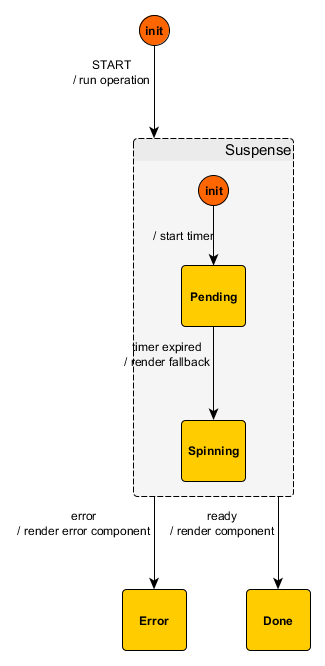Svelte Suspense
Motivation
This example illustrates a simple hierarchical state machine implementing a behavior similar to React Suspense. It also showcases how a state machine definition can be compiled into a standard standalone JavaScript function — this is a key motivation behind Kingly’s API design. Compiling the machine allows us to mostly eliminate the footprint linked to the machine library.
Modeling
The suspense functionality can be summarized by the following state machine:

Implementation

Clone the GitHub repository.
npm install
npm run startMarkup and semantics
The main screen which will hold the loaded image is handled with a suspense functionality:
let albums=[];
function fetchAlbums(intents){
const {done, failed} = intents;
axios.get(iTunesUrl)
.then(res => res.data.feed.entry)
.then(done)
.catch(failed)
}
<div class="app">
<Header />
<div class="albums">
<Suspense task={fetchAlbums} let:data={albums} timeout=10>
<div slot="fallback" class="album-img">
<img alt="" src="https://media.giphy.com/media/y1ZBcOGOOtlpC/200.gif" />
</div>
<div slot="error" class="album-img">
<h1>ERROR!</h1>
</div>
<LazyLoadContainer>
{#if albums}
{#each albums as album, i}
<LazyLoad id="{i}">
<Album {album} />
</LazyLoad >
{/each}
{/if }
</LazyLoadContainer>
</Suspense>
</div>
</div>The default slot content of the Suspense component will be immediately put in the DOM and hidden (display: none). Two things can happen:
- completion is signaled (
doneorfailed) beforetimeoutmilliseconds. In that case, the corresponding slot content (default slot orerrorslot) is displayed as soon as the completion signal is processed - completion is not signaled before
timeoutmilliseconds expires. In that case, the fallback content (e.g. thefallbackslot content) will be displayed. When the default slot content signals completion, it will be displayed. When completion is signaled (doneorfailed), the corresponding slot content (default slot orerrorslot) is displayed as soon as the completion signal is processed
The Album component also benefits from the suspense functionality:
<ul class="album">
<li class="album-item">
<Suspense let:intents={{done, failed}} timeout=0 >
<div slot="fallback" class="album-img">
<img alt="loading" src="https://media.giphy.com/media/y1ZBcOGOOtlpC/200.gif" />
</div>
<a href={link} target="blank" class="link">
<img class="album-img"
on:load="{done}"
src={image}
alt={'itunes' + Math.random()} />
</a>
</Suspense>
</li>
<li class="title album-item">
<a href={link} target="blank" class="link">
{title.slice(0, 20)}..</a></li>
<li class="price album-item">Price:{price}</li>
<li class="date album-item">Released:{formatDate(date, "MMM Do YY")}</li>
</ul>API
The Suspense component admits the following props:
timeout: the number of milliseconds to wait before displaying the fallback slot contenttask: a function to run on starting theSuspensecomponent. That function will receive an object parameter{done, failed}which can be used to indicate termination or failure to the underlying suspense state machine.
The Suspense component also passes on the intents parameter to its children slots. The aforementioned parameter is an object with properties {done, failed} which can be used to indicate termination or failure to the underlying suspense state machine. Both properties are function which can also pass event data if necessary.
For instance, in the previous example, the Album component lazily loads an image. When the image is loaded, completion is signaled and the wrapping <a> DOM element is displayed. In this example, there is no need to pass data with the done or failed events.
In the previous example too, in the main App component, the list of albums is fetched, using the task parameter of the Suspense component. When that is completed, the completion signal with the fetched albums as data is sent to the Suspense component and the album list is displayed.
Takeaways
Kingly machines can be compiled to standard standalone JavaScript functions. The size of the Kingly library is in this case become much less relevant. Kingly takes inspiration here from Svelte, the front-end framework which compiles itself away.
While using a formalized state machine may feel like too much for a simple behavior like Suspense, the technique can however be generalized easily to more complex scenarios — only by modifying the underlying machine. Using a Kingly state machine with Svelte is likely to improve Svelte’s testing history, which is mostly based on end-to-end tests. A Svelte component is a sum of behavior, style, and content. If the behavior is implemented with a Kingly machine, input sequences for the machine can be generated automatically, and testing can be performed independently of the browser or Svelte.
Credit
The example is inspired from previous work by Sai gowtham.
